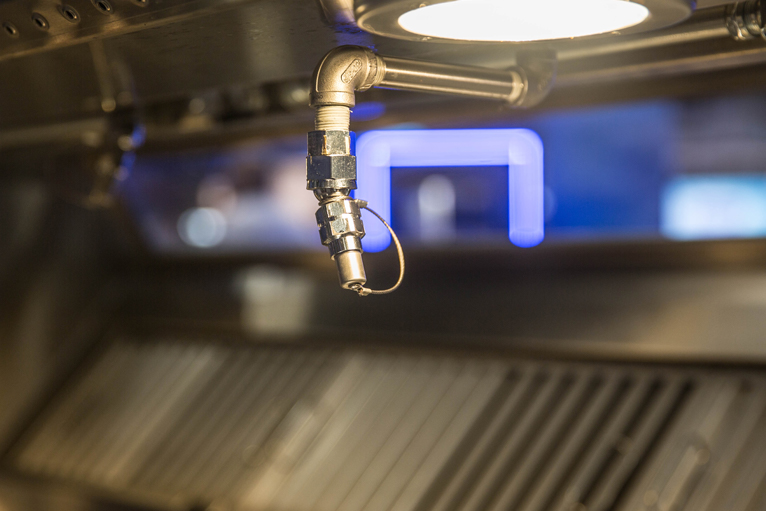COVID has brought constant change to commercial kitchens. A kitchen fire suppression system that’s flexible could be just what you need.
The latest in fire suppression systems is already a staple in commercial kitchens around the world. Innovations make it an easy choice to meet code requirements, keep people and property safe with a dependable system, and give restaurant owners and operators unparalleled ease of use and maintenance for years to come. Plus, the new system meets the rigorous UL 300 standard for fire testing of fire extinguishing systems for the protection of commercial cooking equipment required by NFPA guidelines.
Two methods of coverage meet individual application requirements
The two types of appliance protection configurations are— Appliance Specific, where the appliance location is fixed, and flood systems with overlapping protection configuration that allows kitchen appliances to be moved or replaced without having to move system discharge nozzles. Flood systems future-proof the kitchen design and allow restaurants to adapt to changing consumer tastes or business conditions without re-piping the fire system.
There are now three different fire detection methods — standard thermal link detection or one of two linear heat detection options, pneumatic heat sensitive tubing or electrical linear heat detection. These linear heat detection options give you continuous full hood heat detection that allows appliance movement without changing detection. This range of options helps you right-size system configuration and price for your client’s operation.
Are Electronic Control Systems the future in fire detection?
Electronic Control System (ECS) results from years of rugged electronic fire detection and suppression evolution in vehicles employed in mining, transit, and military applications. Now, this advanced technology is available for commercial kitchens everywhere. Specifically designed to work with the manufacturer’s smart systems for detection, actuation, and system monitoring.
These systems use plug-and-play electronic components for detection, actuation, and manual pull stations, replacing stainless steel cable, corner pulleys, fusible links, and other components where grease buildup can disable a fire system. Installation is quick, maintenance is simple, and grease is neutralized.
The electronic systems are capable of monitoring and releasing two separate hood systems, either separately or simultaneously. This means your clients get the power and convenience of two systems for the price of one. Plus, your customers will enjoy cost-savings over the years from refilling only one agent cylinder and cleaning only one kitchen area from a partial system actuation. Some smart systems provide downloadable reports for problem conditions or actuation events and can be tied to auxiliary controls, such as a building alarm system.
Benefits of kitchen fire suppression system electronic actuation
- Appliance Specific or flood Coverage available.
- Different agent cylinder options.
- Less grease buildup on components.
- Plug-and-play wiring for quick installation — no cables, conduit, or brackets and less cost.
- Fewer nozzles and agent cylinders — less cost.
- Overlapping flood coverage future-proofs cooking line-up.
- Overlapping systems lend themselves to being factory fitted and thereby minimizing costly job site time.
- Linear detection solution will not interfere with UV filters/grease separators.
- No external A/C power is required.
- A standalone system is not dependent on connecting to a water supply.
- An unlimited number of electronic manual pull stations.
- Provides a dedicated interface to supervised auxiliary remote FACP for fire trouble indication.
- Downloadable event logging and recording.
- Trouble indication LED and annunciation.
- Single and dual hazard zone detection with optional independent detection and actuation circuits.
- Simple connection to building alarm/security system.
- First responder’s information available on the GUI
The advancement of connected systems has caught up to kitchen fire suppression systems and provides choice and design flexibility. Electronic detection is becoming more mainstream due to accurate detection and automatic feedback.
Article submitted by:
Susan Ray
Marketing Manager
Amerex Corporation
Leave us a comment below, and we will answer, or if you have any questions, please send us a message here
Subscribe to kitchenventilation.com
Stay up to date by subscribing to Halton’s Commercial Kitchen Ventilation Blogs by entering your email address to subscribe. Halton will provide you with the latest information on commercial kitchen exhaust hoods and systems, pollution control units, air handling, and safety systems. You will receive notifications of new posts by email.


Comments
2 responses to “The latest in kitchen fire suppression system technology and application flexibility”
Interesting article. Is literature available that shows the actual components? Does Amerex offer a water/chemical solution? If yes are the new detection components compatible with that system?
Hi Steve, AMEREX does not offer a dual agent application. Why would you need it when their wet chemical ( which is 50% water) is able to knock out the fire discharging the agent at 240psi getting into the fire thermal column quicker either KP or ZD applications. ZD is my preferred application that complies with DW172 ventilation standard that is highly recommended by Halton in Europe and in some other parts of the world. Literature is available from the AMEREX website or register on Specifi for downloadable component lists.